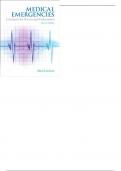Exam (elaborations)
Medical Emergencies Essentials for the Dental Professional, 2Nd Ed Grimes -Test Bank
- Course
- Institution
Test Bank CHAPTER 1 Multiple Choice 1. What is the MOST common emergency to occur in the dental office? A. Mild allergic reaction B. Angina C. Syncope D. Anaphylaxis 2. All of the following procedures will help to prevent an emergency in a dental office EXCEPT: A. accurate medical h...
[Show more]



